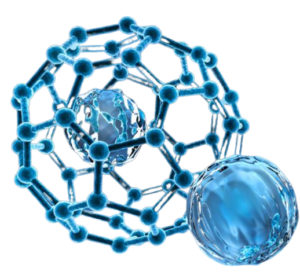Technologies
TECHNOLOGICAL APPROACHES
State-of-the-art approaches for the technological way to combat any type of bacteria, fungi, virus and algae. There are to be highlighted the following:
Antimicrobial coatings
Continuous high-intensity ultraviolet (UV) light
Active metal plating
Nanomaterials
ACTIVE ANTIMICROBIAL COATINGS
The approach DaXem GmbH has chosen is to apply continuously active antimicrobial coatings. The main reason for doing so are elaborated below.
It has been clearly revealed that antimicrobial coating will constantly diminish the number of any given virus and/or bacteria on surfaces between cleanings.
The benefits of antimicrobial coatings are – among other – demonstrated in a Clinical Infectious Diseases paper conducted by the Department of Epidemiology and Biostatistics – University of Arizona College of Public Health. The study consists in intensive care units treated with a continuously active coating over a year, monitoring health care-associated infections (HAI).
Throughout this period live cultures were taken, to result in statistically lower numbers of bacteria, fungi, virus etc. on the surfaces treated. This decrease in bio-burden is interconnected to a statistically significant 36% reduction of HAIs in the treated units.
In two hospitals the following were examinated and monitored: changes in hospital-onset multi-drug resistant organism bloodstream infections (MDRO-BSI), as well as typical hospital related infections for 12 months before and after the application of an antimicrobial coating.
The antimicrobial coating was applied to patient rooms and common areas in the two hospitals.
The result was a 36 % decline in pooled HAIs in the units that received the antimicrobial coating (AMC) and no decline in the control-units. Following the surface applications, the total bacterial CFUs (colony forming unit) in hospital A and B declined by 79 % and 75 % respectively.
High-intensity ultraviolet (UV) light treatment
Another well-known approach to combat the contamination of surfaces with viruses and bacteria is the directly applied illumination by radiation. However, the also well-known potential thread this approach implies are the potential negative health effects on eyes and skin.
Any overexposure to UV light might cause to problems like cataracts, photokeratitis and/or cancer.
Therefore, strict rules and standards are to be complied with when using UV light treatment. The IEC62471:2006 standard clearly states that
“Photobiological Safety of Lamps and Lamp Systems” provides
guidance for the evaluation of the photobiological safety of all
electrically-powered, non-laser sources of optical radiation
emitting in the spectral range 200-3000 nm.
This norm limit drastically, almost forbid, the human and animal exposure to ultraviolet (UV) light, relegating such technology to unoccupied spaces.
Although recent developments have brought about some new UV treatment approaches that will not be harmful to neither the eyes nor might be carcinogenic, the regulation issues are yet to be clarified and/or solved.
These recent solutions have been developed with UV that do not harm neither the eyes nor cause cancer, but still faces regulation challenges. More over those developments do not and does not solve the shading issue, as only the directly illuminated areas are treated for decontaminating purposes.
Other solutions with continuous high-intensity visible blue light with a peak output of 405 nm has been suggested as a potential continuous decontamination solution (Rutala et. al., 2018; Maclean, et al., 2010). Effectiveness, however, is very limited: Violet light (400 nm) only slightly inactivates planktonic P. fluorescent cells.
More over violet light causes reduction of individual cells on a surface only when optimal conditions prevail.
Furthermore, only directly applied High-Intensity UV Light will be effective for the combat against bio-contamination.
Additionally, the safety of long-term exposure to this technology is in question, because it has been shown to damage human cellular membrane structures, which disrupts cell function.
ACTIVE METAL PLATING
Another effective approach to combat contaminated surfaces is the so-called active metal plating and/or the usage of copper- or silver-coated surfaces. Its veritable efficacy, however, is yet to be scientifically proven and/or verified.
One has to note, though, that copper plated surfaces and copper textiles did show a reduction of Healthcare–Associated Infections (HAI) in healthcare and/or medical environment settings (Sifri, Burke, and Enfield, 2016). The antimicrobic propriety of silver is known for thousands of years. The Romans used to drop little silver spheres in their water reservoir.
Additionally, studies led to considered low-quality evidence due to improper randomization and incomplete blinding. An uncontrolled before-after study evaluating copper-impregnated textiles in a long-term care ward demonstrated only a 24% reduction in HAI.
In fact, copper surfaces used in clinical settings result in modest reductions in microbial contamination. One study of copper surfaces and one of copper textiles demonstrated reduction in HAI, but both were at high risk of bias. It also needs to be pointed out that the replacement or renovation of equipment with copper and/or silver plating tends to be very expensive and at times challenging to apply to.
Nanomaterials
The institute Victorian Trades Hall Council’s (VTHC), the Occupational Health and Safety Unit, has declared that “The potential effects of nanomaterials on worker health and that of the general community, as well as on the environment, are largely unknown”.
We in DaXem we avoid the use of nanomaterial, our priority is the safety.
The miniature size of nanomaterials and the way their surfaces are modified to increase the ease with which they can interact with biological systems – the very characteristics that make them attractive for applications in medicine and industry – makes nanomaterials potentially damaging for humans and the environment.

Nanoparticles are likely to be dangerous for three main reasons:
1. Nanoparticles may damage the lungs. We know that ‘ultra fine’ particles from diesel machines, power plants and incinerators can cause considerable damage to human lungs. This is both because of their size (as they can get deep into the lungs) and also because they carry other chemicals including metals and hydrocarbons in with them.
2. Nanoparticles can get into the body through the skin, lungs and digestive system. This may help create ‘free radicals’ which can cause cell damage and damage to the DNA. There is also concern that once nanoparticles are in the bloodstream they will be able to cross the blood-brain barrier.
3. The human body has developed a tolerance to most naturally occurring elements and molecules that it has contact with. It has no natural immunity to new substances and is more likely to find them toxic.
The danger of contact with nanoparticles is not just speculation. As more research is undertaken, concerns increase.
inhaled carbon nanotubes can suppress the immune system by affecting the function of T cells, a type of white blood cell that organises the immune system to fight infections.
According to the USA’s Woodrow Wilson International Centre for Scholars chief science advisor (speaking at a conference organised by the Australian Institute of Occupational Hygienists – AIOH), Dr Andrew Maynard, ‘Whether [the research] is relevant to humans we’re not sure yet. But it does indicate nanometer-size particles and nano-structured materials behave in different ways to what we’re used to.’ One of the big problems is that it’s impossible to know whether a product or substance contains nanoparticles, as current legislation does not require these to be labelled.
The US government safety research body NIOSH has produced a guide which states nanomaterials may interact with the human body in different ways than more conventional materials, due to their extremely small size. For example, studies have established that the comparatively large surface area of inhaled nanoparticles can increase their toxicity. Such small particles can penetrate deep into the lungs and may move to other parts of the body, including the liver and brain.
NIOSH’s Nanotechnology Research Centre (NTRC), has also released an interim report Progress Towards Safe Nanotechnology in the Workplace [pdf] (Feb 2007). The NTRC was established to coordinate and facilitate research in nanotechnology and develop guidance on the safe handling of nanomaterials in the workplace. The report identifies 10 critical OHS areas and reports on the advancements to date. The areas include toxicity and internal dose -determined heart and lung responses to nanoparticles; risk assessment; epidemiology and surveillance – developing guidance for nanotechnology employers and workers on how to implement OHS surveillance programs in the workplace; engineering controls and PPE; and measurement methods.
Sources:
Rutala, W., and Weber, D. (2019, June). Best Practices For Disinfection Of Noncritical Environmental Surfaces And Equipment In Health Care Facilities: A Bundle Approach. Am J Infect Control, 47 (Supplement), A96-A105.
Rutala, W., and Sickber-Bennet, E. (2007). Outbreaks Associated With Contaminated Antiseptics And Disinfectants. Antimicrobial Agents and Chemotherapy (51), 4217-4224.
Sifri, C., Burke, G., and Enfield, K. (2016, December 1). Reduced Health Care-associated Infections In An Acute Care Community Hospital Using A Combination Of Self-disinfecting Copper-impregnated Composite Hard Surfaces And Linens. Am J Infect Control, 44(12), 1565-1571.
Victorian Trades Hall Council’s (VTHC) Occupational Health and Safety Unit: www.ohsrep.org.au/nanotechnology_-_a_new_hazard
Workshop “Safe handling of nanomaterials at workplaces – Practical Guidance for the Safe Use of Nanomaterials” am 27./28.11.2012 in Berlin: https://www.baua.de/DE/Angebote/Veranstaltungen/Dokumentationen/Gefahrstoffe/Nano-2012.html


